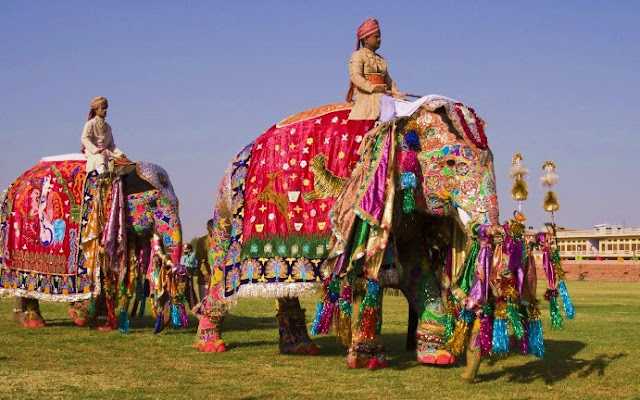Item code: 84/BIN-1
King George
VI
Elephants remain an integral part of religion in South
Asia and some are even featured in various religious practices. Temple
elephants are specially trained captive elephants that are lavishly caparisoned
and used in various temple activities. Among the most famous of the temple
elephants is Guruvayur Keshavan of Kerala, India. They are also used in
festivals in Sri Lanka such as the Esala Perahera.
Year
|
1937
|
Obverse
|
Portrait of King George VI; Lake, mountain and
banana plant.
|
Reverse
|
Seal of
The Reserve Bank of India; 2 decorated white (royal) elephants with mahouts.
|
Watermark
|
The King George VI.
|
Size
|
146 х 83
|
Signature
|
Governor: Sir James Braid Taylor (in office
1 July 1937 - 17 February 1943)
|
Material
|
Cotton fiber
|
Printer
|
Government of
India Mint and the Security Printing Press, Nasik, India
|
Obverse description:
King George
VI
George VI (Albert Frederick Arthur George; 14 December 1895 – 6 February 1952) was King of the United Kingdom and the Dominions of the British Commonwealth from 11 December 1936 until his death. He was the last Emperor of India and the first Head of the Commonwealth.
George VI was the son of King George V and Queen Mary. He was the younger brother of Edward VIII who abdicated from the throne to marry an American, Wallis Simpson. In 1923 George VI married his beloved wife Elizabeth, who later became known as Queen Elizabeth the Queen Mother. They had two children, Princess Elizabeth (Later Elizabeth II) and Princess Margaret (1930–2002).
 |
The traditional profile of the
monarch for a picture on the banknotes and coins. Made with a photo shoots on
the coronation of George VI, made in 1937.
|
He became a very popular king throughout the British Empire. He won admiration during the Second World War (1939–1945) in which he stayed at Buckingham Palace during the most intense months of the blitz. Buckingham Palace was bombed more than twice but he still remained, becoming a symbol of resistance and 'fighting spirit'. He opened the Festival of Britain in 1951 and enjoyed a close working relationship with the war Prime Minister Winston Churchill and invited him to join the royal family on VE Day to celebrate the end of the War.
A heavy smoker, His Majesty King George VI died of lung cancer and was given a large state funeral. He was fifty-six.
In all corners are the acanthus leaves
In all corners are the acanthus leaves. The acanthus is one of the
most common plant forms to make foliage ornament and decoration.
The decoration is made by analogy with the herbaceous plant of
acanthus family, native to the Mediterranean. The shape of its leaves, with a
few sharp edges, resembling a bear's paw, was the basis for the drawing.
Acanthus often represents life and immortality.
Reverse description
Centered, around the seal of The Reserve
Bank of India are 2 decorated white (royal) elephants in festive decorations,
with mahouts on their backs
Elephant takes in the
culture of India very big place, and this is due not only to the fact, that it
is the largest animals, but also with his intellectual qualities and character
traits and good memory of elephants is proverbial.
The Earth is supported and
guarded by mythical World Elephants at the compass points of the cardinal
directions, according to the Hindu cosmology of ancient India. The classical
Sanskrit literature also attributes earthquakes to the shaking of their bodies
when they tire. Wisdom is represented by the elephant in the form of the deity
Ganesh, one of the most popular gods in the Hindu religion's pantheon.
Sometimes known as Ganesha, this deity is very distinctive in having a human
form with the head of an elephant. This was put on after the human head was
either was cut off or burned, depending on the version of the story from
various Hindu sources. Lord Ganesha's birthday (rebirth) is celebrated as the
Hindu festival known as Ganesha Chaturthi. In Japanese Buddhism, their
adaptation of Ganesha is known as Kangiten ("Deva of Bliss"), often
represented as an elephant-headed male and female pair shown in a standing
embrace to represent unity of opposites.
In
Hindu iconography, many devas are associated with a mount or vehicle known as a
vāhana. In addition to providing a means of transport, they symbolically
represent a divine attribute. The elephant vāhana represents wisdom, divine
knowledge and royal power; it is associated with Lakshmi, Brihaspati, Shachi
and Indra. Indra was said to ride on a flying white elephant named Airavata,
who was made the King of all elephants by Lord Indra. A white elephant is rare
and given special significance. It is often considered sacred and symbolises
royalty in Thailand and Burma, where it is also considered a symbol of good
luck. In Buddhist iconography, the elephant is associated with Queen Māyā of
Sakya, the mother of Gautama Buddha. She had a vivid dream foretelling her
pregnancy in which a white elephant featured prominently. To the royal sages,
the white elephant signifies royal majesty and authority; they interpreted the
dream as meaning that her child was destined for greatness as a universal
monarch or a Buddha.
 |
Guruvayur Gajarajan Kesavan
|







No comments:
Post a Comment